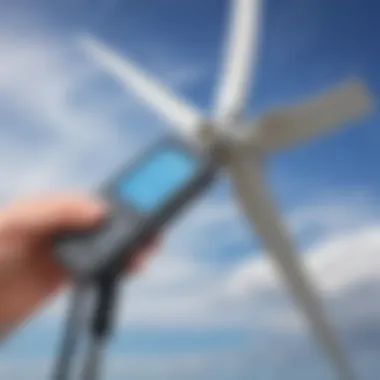Exploring Cutting-Edge Wind Measurement Devices: A Comprehensive Overview


Science Fun Facts
In the world of meteorology and environmental research, wind measurement devices play a critical role in understanding atmospheric dynamics and weather patterns. These instruments, ranging from simple cup anemometers to sophisticated LIDAR systems, provide invaluable data for scientists and researchers. Did you know that the first recorded use of anemometers dates back to the 15th century, demonstrating humanity's enduring curiosity about the forces of nature? As technology advances, these devices continue to evolve, offering more precise and detailed measurements of wind speed and direction.
Discover the Wonders of Science
Exploring the functionality of wind measurement devices unveils fascinating scientific concepts such as airflow dynamics, pressure differentials, and Doppler effects. Through educational videos and animations, children can visualize how these devices work and their significance in predicting weather phenomena. Real-life applications showcase how wind data collected from these devices is utilized in aviation, renewable energy projects, and severe weather forecasting. Understanding the science behind wind measurement enhances our appreciation for the intricate processes governing our atmosphere.
Science Quiz Time
Engage young minds with interactive quizzes focusing on the principles of wind measurement and its importance in meteorology. Multiple choice questions can challenge students to think critically about how wind speed affects various aspects of our daily lives, from sailboat racing to wind turbine efficiency. Brain teasers and puzzles offer a fun way to test comprehension while learning through gamification makes scientific concepts more accessible and enjoyable. Encouraging curiosity through engaging activities fosters a deeper understanding of the dynamics of our natural environment.
Science Experiment Showcase
Bring scientific principles to life through hands-on experiments that demonstrate key concepts in wind measurement. By following step-by-step instructions, students can create their own simple anemometers using everyday materials like cups, straws, and string. A materials list ensures easy access to necessary items, while safety tips and precautions promote a safe and educational learning environment. By conducting these experiments, children can gain a practical understanding of how wind measurement devices function, fostering a curiosity for further exploration in the field of meteorology and environmental science.
Innovative Wnd Measurement Device: Ae Comperhensive Guide
Wind measurement plays a crucial role in meteorology and environmental research, providing valuable insights into wind patterns, weather forecasting, and renewable energy applications. Understanding the significance of wind measurement devices is fundamental to grasp the complexities of wind behavior and its implications across various sectors.
Importance of Wnd Measurement
Understanding Wind Patterns
In the realm of wind measurement, understanding wind patterns is a cornerstone of meteorological analysis. By deciphering how winds move and interact at different altitudes, researchers can predict weather phenomena with greater accuracy. The intricate details of wind behavior, such as air circulation patterns and turbulence dynamics, are vital for creating reliable weather forecasts. Despite its importance, understanding wind patterns presents challenges, mainly in data collection and interpretation. Nevertheless, its role in enhancing weather forecasting precision cannot be overstated.
Impact on Weather Forecasting
The impact of wind measurement on weather forecasting cannot be emphasized enough. Accurate wind data is instrumental in predicting storms, temperature changes, and precipitation patterns. By integrating wind measurements into weather models, meteorologists can produce more nuanced and informative forecasts. However, interpreting wind data requires advanced analytical techniques to extract relevant insights effectively. While wind measurement significantly improves weather forecasting, limitations exist in terms of data resolution and forecast horizon.
Applications in Renewable Energy
Wind measurement devices are indispensable tools in optimizing renewable energy production, particularly wind energy. By collecting precise wind speed and direction data, these devices enable efficient placement and operation of wind turbines. The ability to predict wind patterns contributes to higher energy output and better integration into the power grid. Despite their benefits, wind measurement devices in renewable energy face challenges related to variability in wind patterns and site-specific considerations. Nevertheless, the role of wind measurements in advancing renewable energy solutions is pivotal.


Purpose of Wnd Measurement Devices
Data Collection for Research
The primary purpose of wind measurement devices is to facilitate data collection for research purposes. Researchers rely on accurate wind data to study atmospheric dynamics, climate patterns, and environmental changes. By utilizing advanced sensors and monitoring techniques, these devices capture valuable information essential for scientific investigations. Nonetheless, challenges such as data accuracy and sensor calibration persist in the realm of wind research, posing obstacles to data interpretation and analysis.
Safety in Aviation and Maritime
Wind measurement devices play a critical role in ensuring safety within the aviation and maritime industries. By providing real-time wind data, these devices assist pilots and navigators in making informed decisions during flights or sea journeys. The accurate assessment of wind conditions is vital for avoiding turbulence, optimizing fuel efficiency, and enhancing overall travel safety. Despite their significance, wind measurement devices for safety applications encounter limitations in extreme weather conditions and remote operational settings.
Optimizing Wnd Energy Production
In the context of wind energy production, wind measurement devices contribute to optimizing the performance of wind turbines and enhancing energy production efficiency. By analyzing wind patterns and speeds, operators can adjust turbine settings to maximize power generation and minimize maintenance costs. The utilization of advanced algorithms and predictive models further enhances the accuracy of energy forecasts and grid integration. However, challenges exist in predicting wind fluctuations and ensuring consistent energy output due to inherent wind variability.
Each facet of wind measurement devices contributes uniquely to the overarching goal of gathering precise and reliable wind data. Despite challenges and limitations, these devices remain indispensable in various sectors, shaping the landscape of meteorology, renewable energy, and safety practices.
Basic Principles
In the realm of wind measurement devices, understanding the basic principles is paramount. These principles form the foundation upon which all further advancements and technologies are built. By grasping the fundamental concepts, one can appreciate the intricacies of wind measurement and its critical role in meteorology and environmental research. Discussing basic principles will shed light on key components such as anemometers, wind vanes, and windsocks. Exploring these elements will provide a comprehensive insight into how wind data is collected and analyzed, emphasizing the significance of accuracy and reliability in measurements.
Anemometers
Cup Anemometers
Cup anemometers play a pivotal role in wind measurement due to their robust design and accuracy. The unique feature of cup anemometers lies in their ability to capture wind speed by utilizing rotating cups. This design ensures consistent and precise data collection, making cup anemometers a popular choice in various applications. However, the maintenance of cup anemometers can be labor-intensive, requiring periodic calibration to guarantee optimal performance. Despite this aspect, their reliability and durability make them a preferred instrument for wind speed measurement.
Vane Anemometers
Vane anemometers are renowned for their efficiency in determining wind direction. Their key characteristic lies in the use of a vane that aligns with the wind, providing accurate directional information. This feature makes vane anemometers invaluable in scenarios where wind direction plays a crucial role, such as navigational applications. However, vane anemometers may face challenges in accurately capturing wind direction in turbulent conditions, affecting data precision. Despite this limitation, their simplicity and effectiveness make vane anemometers a significant component in wind measurement devices.
Ultrasonic Anemometers
Ultrasonic anemometers revolutionize wind measurement through their advanced technology and precision. The key characteristic of ultrasonic anemometers is their ability to calculate wind speed and direction using sound waves, eliminating the need for moving parts. This feature enhances reliability and decreases maintenance requirements, making ultrasonic anemometers an efficient choice for monitoring wind parameters. However, the initial cost of ultrasonic anemometers can be high, posing a financial challenge for some users. Yet, their unparalleled accuracy and real-time data acquisition justify the investment, especially in critical applications where precise wind information is indispensable.
Wind Vane and Windsock


Function and Design
The function and design of wind vanes and windsocks are essential in determining wind direction visually. Wind vanes utilize an arrow-like structure that points directly into the wind, indicating the wind's orientation. This visual cue is crucial for basic wind assessments and early weather predictions. Additionally, windsocks, with their characteristic cone shape, offer quick insights into wind direction by fluttering in the wind. Their simple yet effective design makes wind vanes and windsocks valuable tools for various outdoor activities and industrial applications. However, inaccuracies in wind direction readings may arise due to external factors such as obstruction or irregular wind patterns, influencing the reliability of these devices.
Practical Applications
The practical applications of wind vanes and windsocks extend to diverse fields such as aviation, maritime operations, and recreational activities. In aviation, wind vanes provide essential information for take-off and landing procedures, ensuring flight safety. Likewise, windsocks at airports serve as visual indicators of wind direction and intensity, aiding pilots in making informed decisions. In maritime settings, wind vanes assist sailors in navigation, helping them utilize wind direction to optimize their routes. Furthermore, windsocks on ships serve as vital aids for assessing wind conditions while at sea. For recreational use, wind vanes and windsocks assist outdoor enthusiasts in planning activities like sailing, paragliding, or kite flying, enhancing their overall experience. Despite their practical utility, it is crucial to account for external factors that may affect the accuracy and reliability of wind vanes and windsocks in different settings.
Advanced Technologies
In the realm of wind measurement devices, advanced technologies play a central role in enhancing the accuracy and efficiency of data collection processes. These cutting-edge innovations represent a significant leap forward in the field of meteorology and environmental research. By harnessing the power of advanced technologies, researchers and professionals can obtain precise wind data essential for various applications. One key element to consider when delving into advanced technologies is their capacity to revolutionize traditional methods of wind measurement.
Lidar Systems
Principle of Operation
Lidar systems operate on the principle of emitting laser pulses into the atmosphere and analyzing the light scattered back by aerosols, dust, and other particles. This technique allows for the measurement of wind speed and direction based on the Doppler shift of the scattered light. One of the key characteristics of lidar systems is their ability to provide non-intrusive, remote sensing capabilities, making them highly valuable for wind assessment. The unique feature of lidar systems lies in their capacity to offer detailed insights into wind patterns and behaviors without the need for physical contact with the air flow. While lidar systems offer superior data resolution and accuracy, they may face challenges in adverse weather conditions that affect laser performance.
Benefits over Traditional Methods
Lidar systems offer significant advantages over traditional wind measurement methods by providing enhanced spatial coverage and vertical profiling capabilities. Unlike conventional anemometers that are limited to specific measurement points, lidar systems can scan large areas with high precision, offering a comprehensive view of wind patterns. This expanded coverage allows for a more thorough understanding of complex wind dynamics, particularly in challenging terrains or offshore environments. Additionally, the ability of lidar systems to measure wind at different altitudes makes them invaluable for optimizing wind energy production and site assessment.
Applications in Wind Energy
The applications of lidar systems in wind energy are manifold, ranging from wind resource assessment and turbine performance optimization to wake effect analysis and power curve verification. By providing detailed wind profile data, lidar systems enable wind farm operators to enhance energy output and operational efficiency. Moreover, lidar technology plays a crucial role in reducing uncertainties in wind measurements, ultimately leading to more reliable energy forecasts and improved decision-making processes within the wind power industry.
Deployment and Calibration
In our exploration of wind measurement devices, the deployment and calibration play a pivotal role. Effective deployment ensures accurate data collection, crucial for various applications like weather forecasting, renewable energy optimization, and research. Calibration, on the other hand, is essential to maintain the precision and reliability of these devices over time. It involves verifying and adjusting the instrument to ensure consistent and accurate measurements. The meticulous process of deployment and calibration guarantees the integrity of the collected wind data, making it a cornerstone of meteorological and environmental studies.
Installation Considerations
Height and Location


When discussing wind measurement devices, the choice of height and location is of paramount importance. Placing the device at an optimal height above ground level is critical for capturing undisturbed wind data. High installations can reduce interference from surrounding structures or obstacles, while strategic locations like open fields or elevated platforms can offer unobstructed airflow. The unique feature of height and location lies in their direct impact on the reliability and accuracy of wind measurements. However, the drawback could be the cost and complexity associated with taller installations, making it necessary to balance between accuracy and practical considerations.
Maintenance Practices
The maintenance of wind measurement devices is a fundamental aspect of ensuring continuous and reliable operation. Regular maintenance practices involve inspecting, cleaning, and calibrating the instruments to prevent inaccuracies or malfunctions. By adhering to a structured maintenance schedule, operators can enhance the longevity and performance of these devices. A key characteristic of maintenance practices is their role in upholding data quality and instrument functionality. While consistent maintenance can improve device lifespan and accuracy, neglecting these practices could lead to erroneous data collection and compromised results.
Calibration Procedures
Verification Techniques
In the realm of wind measurement, verification techniques are essential to validate the accuracy and precision of the collected data. These techniques involve comparing the device readings against known standards or reference instruments to identify any discrepancies. By employing verification techniques regularly, operators can detect calibration drift or sensor errors, ensuring the reliability of the collected data. The key characteristic of verification techniques is their ability to identify discrepancies and deviations, enabling timely corrective actions to be taken. While these techniques offer increased data accuracy, they may require additional time and resources for implementation.
Accuracy Assurance
Accuracy assurance in wind measurement devices is vital for maintaining data integrity and reliability. This process involves implementing quality assurance measures to validate the accuracy of measurements under varying conditions. By conducting regular accuracy checks and audits, operators can ensure that the devices provide consistent and precise data outputs. The unique feature of accuracy assurance lies in its continuous monitoring of data quality, minimizing errors and enhancing the overall reliability of the collected data. However, this process may involve additional costs and resources to implement, emphasizing the importance of balancing accuracy requirements with operational efficiency.
Challenges and Future Outlook
The challenges and future outlook segment of this groundbreaking article shapes a compelling narrative around the pivotal concerns and innovative strides within the realm of wind measurement devices. Addressing the data accuracy and reliability associated with these devices becomes crucial as we navigate the intricacies of modern meteorology and environmental research. In this section, we delve deep into the evolving landscape of wind measurement, highlighting specific elements that drive advancements and enhance functionalities.
Data Accuracy and Reliability
Factors Affecting Measurements:
Unveiling the nuanced interplay of variables that influence measurement precision is paramount in comprehending the depth of wind data collection. Factors such as environmental conditions, sensor calibration, and device robustness intricately shape the accuracy of recorded data. This article accentuates the intricate dance between these factors, elucidating how each element contributes to the holistic reliability of wind measurements. By scrutinizing these fundamental aspects, readers gain insight into the complexities that underscore reliable data acquisition and analytical precision.
Enhancing Data Quality:
Diving into the efforts aimed at elevating data quality underscores the commitment to precision and efficacy within the field of wind measurement devices. Through meticulous calibration procedures, sensor advancements, and data processing techniques, a concerted effort is made to enhance the overall quality of collected data. This section peels back the layers of these enhancement strategies, shedding light on their impact on research outcomes and practical applications. By exploring these approaches, readers glean a profound understanding of the continuous quest for data quality improvement in the domain of wind measurements.
Emerging Trends
Navigating the horizon of emerging trends unveils a tapestry of technological marvels that are reshaping the landscape of wind measurement devices. Highlighting the fusion of artificial intelligence (AI) into data analysis processes amplifies the efficiency and accuracy of wind data interpretation. By unpacking the integration of AI in this context, readers are exposed to the transformative power of cutting-edge technologies in revolutionizing data insights and forecasting capabilities.
Integration of AI:
Scrutinizing the infusion of AI into wind measurement practices unveils a paradigm shift in data processing and analysis. The intelligent algorithms embedded within AI systems empower researchers to extract deeper insights, predict trends, and optimize decision-making processes. This article dissects the nuances of AI integration, elucidating its role in enhancing the overall efficacy and precision of wind data interpretation. Through an in-depth exploration of AI's applications in this sphere, readers are poised to grasp the transformative potential encapsulated in this technological convergence.
Miniaturization of Devices:
The trend towards miniaturization heralds a new era in the portability and scalability of wind measurement devices. By condensing intricate sensor technologies into compact forms, the accessibility and versatility of these devices are greatly enhanced. This section articulates the significance of miniaturization in streamlining data collection processes and expanding the reach of wind monitoring networks. Through a detailed examination of the advantages and potential drawbacks associated with miniaturized devices, readers garner a holistic understanding of this burgeoning trend shaping the future of wind measurement technologies.







